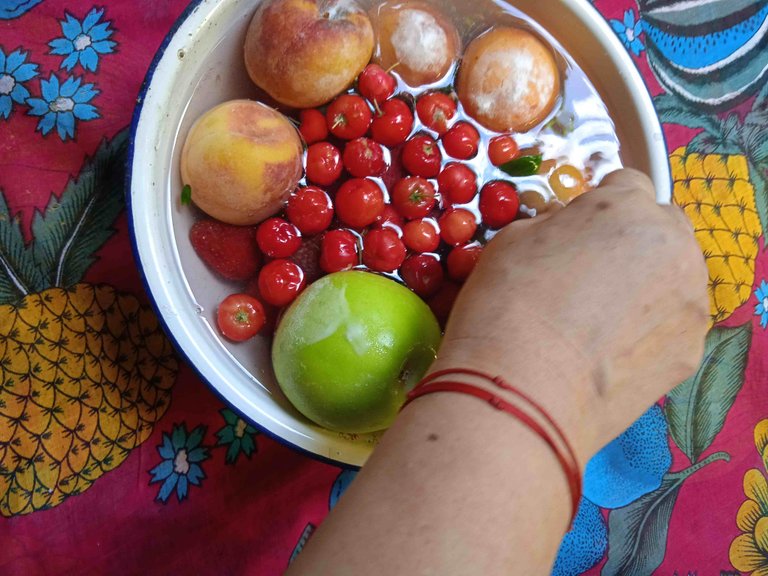
The etiological agents of the most important food-borne diseases (Part I: BACTERIA)
The etiological agents of the most important food-borne diseases (Part II: VIRUSES)
The etiological agents of the most important food-borne diseases (Part III: VIRUSES)
The etiological agents of the most important food-borne diseases (Part IV: PARASITES)
The etiological agents of the most important food-borne diseases (Part V: PARASITES)

¡Hola a todos! Feliz semana, espero sea llena de éxitos y momentos felices. Hoy he querido hacer un post diferente para mi amada comunidad Plant Power (Vegan). Es una EXCEPCIÓN, la cual me permitiré porque creo es importante ofrecer información a los usuarios, la cual esté relacionada con las normas de higiene y manejo de alimentos; así que hoy les hablaré de la DESINFECCIÓN DE FRUTAS Y VEGETALES. Hoy sólo abordaré este tema, aunque hay muchos otros tópicos de los cuales hablar, pero por ahora sólo me referiré a este proceso. Cabe señalar que previamente, en esta comunidad se han publicado posts informativos vinculados con salud y los alimentos, los cuales comparto a continuación:
The etiological agents of the most important food-borne diseases (Part I: BACTERIA)
The etiological agents of the most important food-borne diseases (Part II: VIRUSES)
The etiological agents of the most important food-borne diseases (Part III: VIRUSES)
The etiological agents of the most important food-borne diseases (Part IV: PARASITES)
The etiological agents of the most important food-borne diseases (Part V: PARASITES)

Las frutas y vegetales, desde que están en el campo o en donde sean cultivadas, están expuestas a diversas fuentes de contaminación. Esta contaminación también se presenta durante la cadena de comercialización, pues serán recolectadas, almacenadas, transportadas y expuestas a la venta, y durante todo este proceso son tocadas por manos humanas, están en contacto con contaminantes, hay insectos y animales diversos que pueden dejar sus excretas encima de ellas, como también hay insectos que las parasiten. Así que, indudablemente, las frutas y vegetales pueden estar contaminados con microbios, bacterias, parásitos, virus, hongos, toxinas, polvo y otras sustancias nocivas para la salud del ser humano; de allí la importancia de lavarles y desinfectarles apropiadamente.

Así que lavar y desinfectar bien frutas y vegetales, especialmente si los vamos a consumir crudos, es un proceso que nos evitará muchos dolores de cabeza, muchos gastos y muchos inconvenientes, porque eliminaremos o reduciremos notablemente los patógenos que puedan afectar nuestra salud; además, la comida sabe mucho mejor así y la podemos consumir con tranquilidad, además de que podemos proteger la salud de nuestra familia.

Yo empleo diversas formas de desinfectar las frutas y verduras, especialmente porque en mi país hay muchísimas fallas en la higiene e integridad de los alimentos, pues no existe una supervision y/o control sanitario eficiente para garantizar al consumidor alimentos higiénicos. Por otra parte, no dispongo de agua potable en mi casa, compro agua proveniente de pozo profundo, que también requiere ser potabilizada. Es más, las frutas y vegetales que cosecho de mi solar, también los lavo y desinfecto, porque sé que hay muchos insectos y animales que pueden contaminarlos.


The first thing to do is wash the food with plenty of water. This will allow any material, such as dust or dirt, or any liquid (for example toxins, animal urine, etc.), to be removed from the surface of the fruits and vegetables, by a drag mechanism.
Once well washed, it is necessary to immerse them in enough DRINKING water, to which we will add in sufficient quantity, some disinfectant element, such as baking soda, vinegar, chlorine or some specific product for disinfection. In this case I used baking soda, approximately a tablespoon, for that amount of fruits that I show in the photos, (by the way, I took these when I made this recipe some time ago, but they are not the same photos). Here I also want to make a point: Do not mix baking soda with vinegar, because even if a chemical reaction is seen between the two, they remain without effects, nullified. Something else, lemon has no disinfectant power, nor does it slightly heat or blanch cabbage, cauliflower or broccoli.
Disinfection times vary, but I prefer more than too little, so I leave the fruits and vegetables submerged for an hour, during which time I rotate the foods, so that they are all completely disinfected.
After that time, I drain and rinse with plenty of DRINKING WATER; and they are ready for consumption. However, generally I remove the peel from fruits and vegetables that I am not sure are 100% organic, and I do this because high levels of the agrochemicals that have been used can accumulate in the peel. in their cultivation, and these are really harmful to human health; so better safe than sorry.







Hoy le explicaré una forma de desinfectar frutas y vegetales, es realmente muy sencilo de hacer:
Lo primero que hay que hacer es lavar con abundante agua los alimentos. Esto favorecerá que cualquier material, como polvo o tierra, o cualquier líquido (por ejemplo toxinas, orín de animales, etc.), pueda ser removido de la superficie de las frutas y verduras, por un mecanismo de arrastre.
Una vez bien lavados, es necesario sumergirlos en suficiente agua POTABLE, a la cual añadiremos en cantidad suficiente, algún elemento desinfectante, como es bicarbonato de sodio, vinagre, cloro o algún producto específico para la desinfección. En este caso yo utilicé bicarbonato de sodio, aproximadamente una cucharada, para esa cantidad de frutas que muestro en las fotos, (por cierto, estas las tomé cuando hice esta receta tiempo atrás, pero no son las mismas fotos). Aquí también quiero hacer un inciso: No mezclen bicarbonato con vinagre, porque aunque se vea una reacción química entre ambos, estos quedan sin efectos, anulados. Algo más, el limón no tiene poder desinfectante, como tampoco calentar o blanquear ligeramente el repollo, el coliflor o el brócoli.
Los tiempos de desinfección varían, pero yo prefiero que sobre a que falte, así que dejo sumergidos las frutas y vegetales por una hora, lapso en el cual voy rotando los alimentos, para que todos sean desinfectados completamente.
Transcurrido ese tiempo, escurro y enjuago con abundante AGUA POTABLE; y ya están listos para consumo. No obstante, por lo general a las frutas y verduras de las cuales no tengo la certeza de que son 100% orgánicas, les quito la cascara, y esto lo hago, porque en la cáscara pueden acumularse altos niveles de los agroquímicos que se hayan empleado en su cultivo, y estos son realmente nocivos para la salud humana; así que mejor prevenir que lamentar.

Como pueden ver, es un proceso súper simple, que es indispensable cada vez que usemos estos alimentos en la cocina. Y si se preguntan qué enfermedades pueden evitarse, a continuación les menciono algunas: Parasitosis, intoxicaciones, gastroenteritis, amebiasis, hepatitis, cólera, entre otras. Cabe señalar que este tipo de enfermedad puede ser mortal, especialmente en niños, ancianos o personas con el sistema inmune deprimido.


Aquí termino mi post de hoy. Espero que el mismo sea de utilidad, a efectos de informarles y concientizarles acerca de un tema tan importante para nuestra salud, como es la desinfección de frutas y vegetales. Me despido de ustedes, deseándoles un hermoso día o noche, y recuerden: No todos los días son iguales y más importante aún: Todo lo que das, todo lo que haces, inexorablemente volverá a ti. ¡Abrazos!

These photos are my own, and were taken with a Xiaomi REDMI NOTE 9A phone / Estas fotos son de mi propiedad, y las tomé con un smarthone Xiaomi REDMI NOTE 9A
This time I'm using a divider that @doriangel gave me. Thank you very much for this beautiful gift. / En esta ocasión estoy usando un divisor que me obsequió @doriangel. Muchas gracias por este bello regalo.

Todo el contenido es de mi propiedad y está sujeto a derechos de autor // All content is my property and subject to copyrigh



 Delegations welcome!
Delegations welcome!

One can never be too safe and this is an excellent method that you’ve demonstrated here. 😁🍑🍋🥰
It's true, there's no way to be absolutely sure, but you do the best you can. Thanks for stopping by to read and comment. Sorry to reply late, there are a lot of power outages here.
I hope you're well. Greetings @itsostylish
very handy advise and it does make sense. I know vinegar and baking soda are excellent natural disinfectants
Thank you very much for your words. Both are good disinfectants, but they must be used separately, because when combined, they nullify their respective disinfectant power.
Greetings @latinowinner
Washing the fruit thoroughly is a wise choice because the use of pesticides can be really brutal. Sad but fruit is an important thing in filling the body's nutrition.
The use of pesticides is always exaggerated, well, in fact I don't even like to use a little bit, and yes, you have to wash the fruits and vegetables very well, because sometimes they are watered with gray water.
Thanks for reading and commenting @aswita, greetings.
Super interesante el tema de desinfección de alimentos. Saludos.
Hola @yanimedina , gracias por tu visita. Creo que es un tema que debe ser recurrente siempre, especialmente en el área gastronómica, pues hay personas que pueden no tener esta información.
Saludos
I'm always a fruit girl🍓🍒🍉🍎🍊🍍🍌🍋🥝🍅🥕🥥🍇🍐🥭🍍
The thumbnail picture drew me in to read what the post was about.
It's quite informative and enlightening.
Thank you for sharing
I congratulate you for eating a lot of fruits, that is super healthy.
Thank you for reading and commenting, I hope the information is useful to you.
Greetings @love1506
Yes It is very helpful.
Thank You 😊
Yes, you have to be very careful about washing fruits, vegetables and vegetables. I usually wash them with vinegar. Excellent recommendation.
Vinegar is another quite effective alternative, I use it too. Thanks for your visit @marilui91
Greetings
Holaaa!
Gracias por mostrarnos tu tips para desinfectar los vegetales y frutas, yo uso un método muy parecido pero solo dejo remojando en Agua con Bicarbonato 10 a 15 minutos, definitivamente tenemos que ser muy meticulosos con la limpieza de nuestros vegetales.
Saludos y feliz día @sirenahippie 🤗🌹
Hola @carisma77, por aquí respondiéndote tarde, no está fácil el tema eléctrico en el país. Pues sí, el bicarbonato es bien efectivo, así como el vinagre y el cloro para desinfectar, ya que las frutas y vegetales en su mayoría, son cultivadas, recolectadas, transportadas y comercializadas con pocas normas sanitarias.
Espero que estés bien. Saludos.
Este tema es muy importante porque de eso depende nuestra nutrición y salud. Yo por lo general utilizo vinagre blanco, es especial para desinfectar, ente otros usos de higiene. Saludos
El vinagre blanco también es muy efectivo @hylene74 así que también es válido para este proceso, yo también lo uso, e incluso lo empleo en la limpieza de pisos, superficies y en el lavado de ropa.
Gracias por tu visita, saludos.
Que buena información y que grandes fotos! felicidades! un saludo!
Gracias por tu visita y comentario @cocinator, sí, las fotos quedaron bellas, ese día había una luz muy linda.
Saludos
Thank you for reminding us of the importance of washing the fruit first, sis. Because the pesticides and poisons that farmers spray on the fruit really damage the vitamin content in the fruit for the body.
In addition to agrochemicals, there are also other contaminants and pathogens, which is why it is mandatory to maintain hygiene in our food.
Thank you for your visit.
Greetings @cacasa26
This is a well written information,
Fruits and veggies should be carefully washed with baking soda before consumption, to avoid causing harm to our health.
You can also use white vinegar, it will have the same effect, or bleach, but in a small amount and rinse very well.
Thank you for your visit and comment @yummycruz1
Greetings
Muy interesante toda esta información que nos compartes, sin embargo, tengo entendido, porque lo he leído, que el vinagre no tiene poder desinfectante, que lo mejor es usar unas gotas de cloro. Saludos 😺